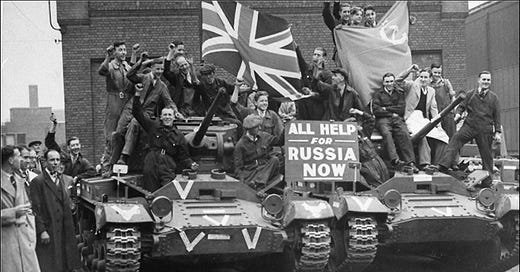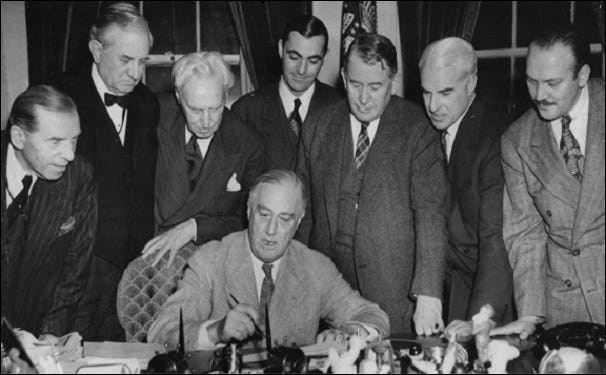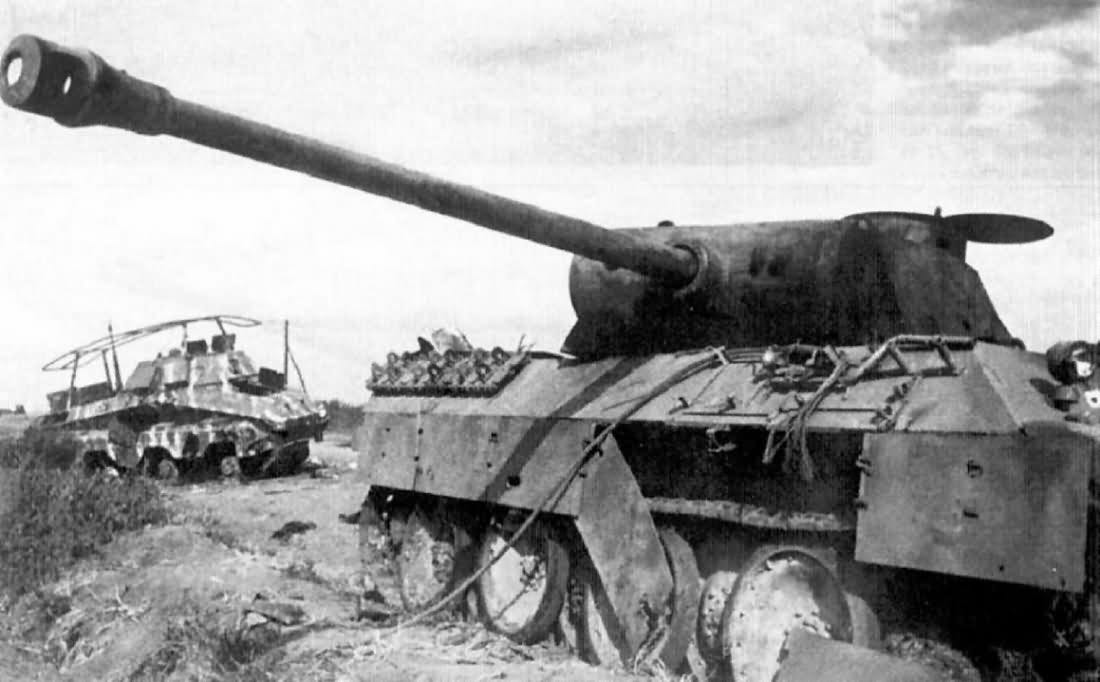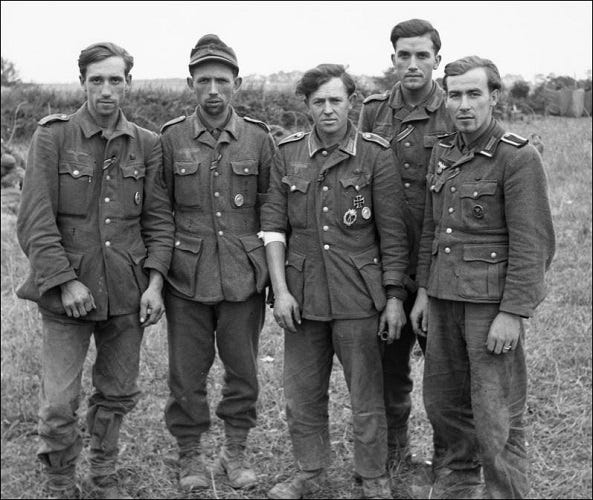Each year on 9 May, Russia celebrates Victory Day: the anniversary of Nazi Germany’s unconditional surrender to the nations of the Grand Alliance. This is a purely Russian observance; in the US and the UK, VE (Victory in Europe) Day falls on 8 May. The discrepancy of dates is explained by a Soviet objection that the surrender ceremony at General Dwight D. Eisenhower’s SHAEF headquarters at Reims, France on 8 May did not adequately include the USSR. Thus the performance was repeated in Berlin late on 8 May (9 May Moscow time), with the Red Army’s Marshal Georgy Konstantinovich Zhukov presiding.
Stalin’s complaints on this occasion were characteristically petulant:
Today, in Reims, Germans signed the preliminary act on an unconditional surrender. The main contribution, however, was done by Soviet people and not by the Allies, therefore the capitulation must be signed in front of the Supreme Command of all countries of the anti-Hitler coalition, and not only in front of the Supreme Command of Allied Forces. Moreover, I disagree that the surrender was not signed in Berlin, which was the center of Nazi aggression. We agreed with the Allies to consider the Reims protocol as preliminary.
The Soviet leader’s claim that the USSR played the major role in the defeat of Nazi Germany is embraced with fervor in Russia, and broadly accepted in the West. This much is certainly true: The German Army’s losses on the Eastern Front were extremely heavy and ultimately catastrophic, and the Red Army’s victory came at a terribly high price. But that victory was made possible by the Grand Alliance, as Winston Churchill so memorably christened it. Absent that alliance with the United States and the United Kingdom it is more than probable that the Soviet Union would have gone down to defeat.
Not that the late USSR and Russia today ever showed genuine gratitude for the contributions of its allies. During the war, the Stalin regime treated the US and the UK with unrelenting suspicion and distrust, and its own war aims were entirely selfish. Failure to meet the USSR’s maximum aid demands was denounced as one more example of capitalist duplicity. As the regime told it, American and British assistance was tendered grudgingly and tardily—there being many in the “ruling circles of the imperialist powers” who wished simply to see Germany and the USSR fight it out to the point of mutual exhaustion. The supposed reluctance of the US and the UK to establish a Second Front was trumpeted as proof of this sinister conspiracy. And though the USSR is no more, that myth lives on.
After the war the USSR and later Russia consistently minimized the significance of the alliance, repeating Stalin’s claim that it played a decidedly secondary role in the defeat of Nazi Germany. This was a legend flattering to the Worker’s Paradise and the Russian Motherland alike—a continuation of the propaganda line adopted by the regime during the war. Stalin and his successors trumpeted the Great Patriotic War for the Motherland (to give it its official title in Soviet historiography) as proof for the ages of the superiority of “scientific socialism.” In the post-Soviet era this line has been suitably modified to align with the tenants of Russian nationalism. But there’s somewhat less to these pleasing formulations than meets the eye.
The assistance provided to the USSR by the Western Allies fell under two headings: direct and indirect. The former consisted of material aid provided to the USSR via Lend-Lease; the latter was embodied in the Western Allies’ actual war effort. While the USSR fought a straightforward one-front land war, the Western Allies engaged in a complex three-dimensional global conflict: The Battle of the Atlantic; the campaigns in North Africa, Sicily, Italy and northwest Europe; the combined strategic air offensive; the war in the Pacific and East Asia. Together, this direct and indirect aid provided the Soviet Union with its margin of victory.
Direct material aid from the Western allies flowed to the USSR on a scale that few people realize today. Consider the following list — a very partial list — of the aid provided by the US alone:
Over 400,000 trucks and jeeps, plus more than 35,000 motorcycles. By 1945 almost 40% of the trucks in service with the Red Army were US models and these were far superior in performance and reliability to their Soviet-built equivalents. Virtually the entire production of the Studebaker truck factory in South Bend, Indiana, went to the USSR. In fact, about 100,000 more trucks were provided via Lend-Lease than were produced domestically in the USSR between 1941 and 1945
Some 12,000 armored vehicles of various types: tanks, armored cars and armored halftracks. More than 4,000 M4 Sherman medium tanks were delivered and some Red Army tank brigades were equipped exclusively with the type. The Red Army used the M3 armored scout car (3,310 delivered) to motorize the submachine gun companies of its Guards tank brigades. Many of the Red Army’s mechanized reconnaissance units had US M3 armored halftracks in place of Soviet-built armored cars
11,400 aircraft including 2,097 P-40 fighters 4,746 P-39 fighters, 2,400 P-63 fighters and 2,908 A-20 twin-engine light bombers
1,900 steam locomotives and 65 diesel locomotives plus more than 10,000 railroad cars of various types
1 million miles of field telephone cable
82 million pounds of barbed wire
Over 2.5 million tons of petroleum products.
500 million pounds of aluminum. Almost all the aluminum used in Soviet wartime aircraft production came from the US
430 million tons of steel bars
5 million pairs of military footwear
4.5 million tons of foodstuffs including 14 million pounds of canned beef, 300 million pounds of canned pork, 243 million pounds of dried eggs, 160 million pounds of dried milk, 130 million pounds of milled rice, 500 million pounds of dried beans and 1.5 million bushels of wheat
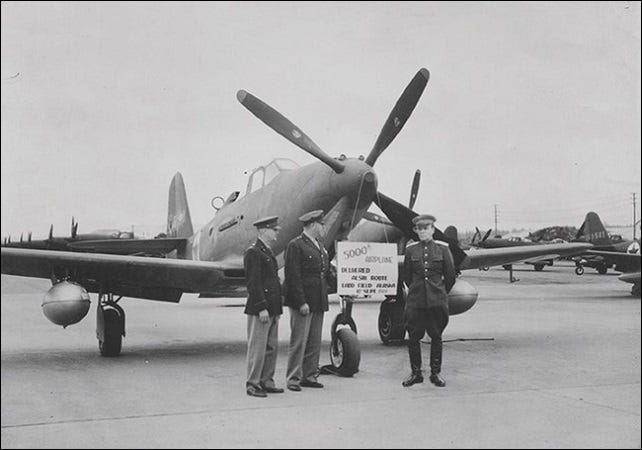
Besides all this US aid the Soviet Union received considerable assistance from the UK, including 7,000 aircraft of various types, over 5,000 tanks, over 5,000 antitank guns, over 4,000 trucks and 27 naval vessels including a battleship.
Lend-Lease benefited the USSR’s war effort in many ways. For example, the military vehicles provided via Lend-Lease made it possible for Soviet industry to concentrate on production of tanks, self-propelled assault guns and artillery. They also enabled the Red Army fully to motorize its artillery units and the infantry units of its armored formations, and to move supplies much more rapidly. In their absence, the mobility and combat power of the Red Army as a whole would have been measurably lower.
But even more significant—though perhaps less immediately obvious—was the value to the USSR of the Western Allies’ own military effort.
From the beginning of the Nazi-Soviet War, Hitler was distracted by events elsewhere. In June 1941, with the United States not yet engaged, such distractions were minor. The fighting in North Africa and the Battle of the Atlantic seemed by comparison with the Eastern Front to be sideshows, while the British strategic bombing offensive against Germany had so far failed to produce results. But as the months passed and the US entered the war, events in distant theaters exercised a growing—for the Germans baneful—influence on the Eastern Front.
The Battle of El Alamein (23 October-11 November 1942), the Allied invasion of North Africa (Operation TORCH, 8-16 November 1942) and the subsequent Tunisian campaign (November 1942-May 1943) induced Hitler to divert major reinforcements from the Eastern Front to North Africa in an attempt to succor Rommel’s Afrika Korps and bolster up the Italians. But in the end Tunisia was lost, with 230,000 German and Italian troops taken prisoner. This defeat, coming on the heels of the Stalingrad debacle, undermined the German position on the Eastern Front in three ways. First, it intensified the manpower crisis already affecting the German Army. Second, it raised a direct threat to Italy, forcing the Germans to divert even more forces to the Mediterranean theater. Third, it subtracted Italy from the list of Germany’s Eastern Front allies. All this worked greatly to the advantage of the USSR.
But though El Alamein, Tunisia and Stalingrad were serious reverses—and to some extent marked the war’s psychological turning point—the German Army in the East was not yet defeated. The decisive military turning point came in the Battle of Kursk (5 July-23 August 1943). That summer, the refurbished German Army attacked with the intention of cutting off and destroying the major concentration of Soviet forces stationed in in the Kursk salient (Unternehmen Zitadelle—Operation CITADEL). In the greatest tank battle of the war both sides suffered astronomically high casualties and the Germans seemed on the brink of a decisive breakthrough by mid-July. But on 12 July, Hitler ordered his commanders to suspend the offensive. Two days earlier US and UK forces had invaded Sicily and the threat thus posed to Italy and southern France convinced the Führer that CITADEL had to be stopped so as to release troops for Italy. This set the stage for a Red Army counterattack in the Kursk sector that soon expanded into a full offensive. And having thus seized the initiative on the Eastern Front, the Soviets were never to relinquish it.
After Kursk the pressures of a multifront war squeezed Germany more and more. The Italian Front absorbed some 25-35 divisions. More than 40 divisions were stationed in France in anticipation of the now-inevitable Allied invasion. More still stood idle in occupied Denmark and Norway. The US/UK Combined Bomber Offensive (Operation POINTBLANK), launched in the spring of 1943, not only devastated urban Germany but diverted major elements of the Luftwaffe from the Eastern Front for the defense of the Reich. In addition to aircraft, thousands of flak (antiaircraft) guns were required. By 1944 more than 2,500 medium and heavy flak gun batteries (10,000 88mm and 128mm guns) were defending Germany, each gun requiring a crew of a dozen men and countless thousands of rounds of ammunition. All this deprived the German Army on the Eastern Front of badly needed manpower, firepower and air support.
The break came in the summer of 1944, when the German Army suffered twin catastrophic defeats at the same time: in Normandy and Byelorussia. The Allied invasion of France (Operation OVERLORD) on 6 June 1944 and the subsequent Battle of Normandy ended with the virtual annihilation of the German Army in France. Some 40 divisions were destroyed or so battered as to be rendered combat ineffective, with almost 400,000 German troops killed, wounded or taken prisoner. By the time the Allied advance stalled due to supply problems, US and British forces had reached the western border of the Reich.
The Red Army’s 1944 summer offensive (Operation BAGRATION) opened on 23 June 1944 and by the time it had run its course, German Army Group Center was smashed. Of its 34 divisions, 28 were completely destroyed, with 450,000 troops killed, wounded or taken prisoner—a full quarter of the German Army on the Eastern Front. The Red Army’s advance liberated almost all occupied Soviet territory and, in the north, brought it close to the border of East Prussia. Though Germany was to fight on for another eight months, with OVERLORD and BAGRATION the Grand Alliance had effectively won the war.
Afterwards there were those in Russia and elsewhere who minimized the Western Allies’ contribution to that victory—claiming, as noted above, that the aid provided to the USSR by the US and the UK was grudging and tardy. That was Stalin’s refrain from 1941 to 1945, and of his successors up to the present day. But the record is clear that in fact, aid was provided immediately and unstintingly within the limitations imposed by distance, available resources and enemy action—as shown by the high casualties suffered by the Allies’ Arctic convoys carrying aid to the Soviet port of Archangel. In July 1942, for example, convoy PQ 17 lost 24 out of 35 merchant ships to German U-boats and air attacks. And the Persian Corridor, which became the main conduit for Lend-Lease aid to the USSR, was a gigantic, complex logistical undertaking that involved thousands of Allied troops and civilian workers.
In retrospect it appears doubtful that the USSR, fighting alone or even in alliance with the UK, could have defeated National Socialist Germany. What made the difference was the addition of the United States, with its incomparable productive capacity, to the Grand Alliance. Winston Churchill certainly knew this. Upon hearing the news of the Japanese attack on Pearl Harbor he breathed a sigh of relief, remarking that victory was now inevitable.
Stalin knew it too. Indeed, his nagging doubts about the USSR’s ability to stand up to a German attack dictated his policy between 1939 and 1941: peace with Germany at any price, at least until the country and the Red Army were ready for war. In his memoirs, Nikita Khrushchev tells how in a private conversation Stalin candidly admitted that without the help of the Western Allies, the USSR would have lost the war. Presumably, he knew what he was talking about.
Publicly, however, Stalin took the opposite line, establishing an epic narrative of patriotic heroism with the triumph over Nazi Germany at its center. And though much disappeared with the fall of the USSR, that narrative has survived. V. Putin appealed to it in his Victory Day speech this year, and it’s the key component of his regime’s propaganda campaign in support of the war with Ukraine.
The charge that Ukraine is a hotbed of neo-Nazism, colluding with foreign powers to destroy Russia, may sound ludicrous to outside audiences. But inside Russia it summons up memories of past glory while maximizing the sense of grievance and plain paranoia that constitute nationalist sentiment in a diminished and declining power. So the facts concerning the Great Patriotic War for the Motherland and how it was won are well worth retrieving from the memory hole in this time of troubles for Russia, Ukraine and the world.
